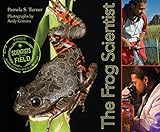The Solution to Reading Comprehension
Lessons & Units :: The Frog Scientist 5th Grade Unit
Paired Text Questions: The Frog Scientist & "Frogs at Risk"
Lesson Plan
The Frog Scientist | 950L

- Learning Goal
- Integrate information from the non-fiction reading passage “Frogs at Risk” and the non-fiction book The Frog Scientist to write or discuss the problems facing amphibian populations around the world and their possible causes.
- Duration
- Approximately 20 minutes
- Necessary Materials
- Provided:
- Questions
- Non-fiction reading passage “Frogs at Risk”
Not Provided:
The Frog Scientist
- Questions 1 and 2 refer to the non-fiction passage “Frogs at Risk.” Questions 3 and 4 refer to the non-fiction book The Frog Scientist. Questions 5 and 6 refer to both the passage and the book.
- Student versions of the questions are in the 'Texts & Materials' tab.
Part 1: "Frogs at Risk"
Before reading the passage show your students the location of Ecuador, using either the map with the text or a larger map.
Read the passage “Frogs at Risk” out loud to your students. Alternatively, students can read the passage independently or as a group.
Question 1: According to the text, what is the risk for many species of frogs and toads in Ecuador?
Sample student answer: They are at risk of dying out and becoming extinct.
Question 2: What are three possible causes of this risk given by scientists?
Sample student answer:
- One cause is that the amphibians are losing their habitat, or where they live.
- Another cause is that they are getting sick.
- There are also changes in the weather and pollution that scientists believe have caused the decline in populations of amphibians.
Part 2: The Frog Scientist
Question 3: What was Tyrone Hayes trying to find out with his experiment on the frogs from Dugway Pond?
Sample student answer: Tyrone was trying to find out how the pesticide atrazine affects frogs.
Question 4: What are the two main reasons why Tyrone Hayes wants to know how atrazine affects frogs?
Sample student answer: Tyrone wants to know whether atrazine has something to do with the drop in the number of frogs around the world. He also wants to know how atrazine affects people.
Part 3: “Frogs at Risk” and The Frog Scientist
Question 5: How might Tyrone’s experiment help other scientists understand what is happening to amphibian populations in North and South America?
Sample student answer: If Tyrone’s experiment shows that the pesticide atrazine creates deformities in male frogs so that they cannot reproduce, it might help other scientists to better understand why some frog populations that have been similarly exposed to pesticides are decreasing.
Question 6: How might Tyrone’s work save amphibians?
Sample student answer (will vary and could include):
If Tyrone can show that atrazine harms frogs, his work could lead to limits on the use of atrazine. As is suggested in the passage, people could try to persuade governments to pass laws that would require farmers to use pesticides that do not hurt amphibians or other animals, and this could help save frogs and other amphibians.
Texts & Materials
Standards Alignment
(To see all of the ReadWorks lessons aligned to your standards, click here.)



I love this
Wonderful! This is the one am looking for.....
Great for improving students' comprehension.
Great resource in preparing for PARCC
This is just what I was looking for. Thanks
Great for PARRC practice writing information.
I like the completeness of the information. Great time saver!
I love these!!